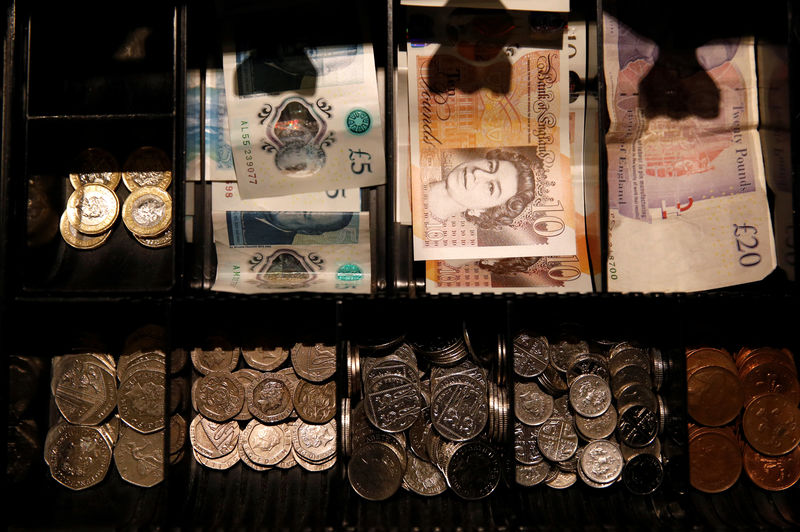 © Reuters. Pound Sterling notes and change are seen inside a cash resgister in a coffee shop in Manchester
© Reuters. Pound Sterling notes and change are seen inside a cash resgister in a coffee shop in Manchester(The opinions expressed here are those of the author, a columnist for Reuters.)
By Jamie McGeever
LONDON (Reuters) – The likelihood of a hard Brexit, where the UK economy crashes out of the European Union without securing a trade deal, is rising once again. And hedge funds smell blood again.
Funds and speculators trading U.S. futures markets are once again turning their guns on sterling, extending their net short position for the second week in a row, something they haven’t done for over two months.
The latest Commodity Futures Trading Commission figures for the week ending Nov. 6 show funds increased their net short sterling position by 4,317 contracts to 56,799 contracts. That’s a $4.6 billion bet that the pound will fall.
(Graphic: Sterling Positions vs. cable – https://tmsnrt.rs/2PlgsNX)
(Graphic: CFTC funds’ sterling positions – https://tmsnrt.rs/2QCEksM)
The bearish turn comes against a renewed wave of negative domestic Brexit headlines for the pound: more government resignations, a cabinet divided more than ever, and growing signs parliament won’t back Theresa May’s proposed compromise with the EU.
Funds and speculators had gradually scaled back their net short CFTC sterling position for most of last month to $3.8 billion from $6.5 billion in mid-September, which was the largest bet against the pound since May last year.
But that came to an abrupt halt in the last two weeks. And if the UK political backdrop deteriorates further, don’t be surprised if sterling tests and then breaks below the $1.2650 low that has been in place since April last year.
There’s certainly room for specs to expand their net short position. As recently as late September it was nudging 80,000 contracts, while in March last year it reached a record 107,844 contracts worth $8.4 billion.
In September, the pound was as high as $1.33; in March last year it was as low as $1.22. It’s currently hovering just above $1.28, so if funds intensify their attack on the pound, that $1.22 low could soon come back into view.
Currency traders may already be bracing for that lurch lower. Implied one-month sterling/dollar volatility rose above 11 percent on Monday for the first time in nearly two years, and euro/sterling one-month implied vol hit its highest in a year at 8.7 pct.
The difference between sterling/dollar vol and euro/dollar vol is now its widest in over two years.
(Graphic: Sterling vol vs. euro vol – https://tmsnrt.rs/2QCawfZ)
Sterling is not alone in its struggle against the dollar, which is on the march against all major currencies. But it has the added drag of Brexit, which is infecting the domestic UK growth outlook.
The European Commission last week released its latest 2019 growth projections. Britain was bottom of the 28-strong list of EU nations, alongside Italy, with growth next year forecast to be just 1.2 pct.
Bank of England Deputy Governor Ben Broadbent said on Monday that the effect of Brexit uncertainty on business investment had intensified this year, and that growth in the fourth quarter looks likely to slow.
With less than five months left before Britain and the EU officially part ways, a one-in-four chance remains the sides will fail to reach a deal on the terms of departure, according to economists polled by Reuters last week.
Taken together, falling investment, slowing growth and political paralysis paints a pretty bleak picture for the pound. How much of that is reflected in the exchange rate and investor positioning already will determine how much lower sterling goes from here. If at all.
(By Jamie McGeever, editing by Larry King)
Source: Investing.com




























